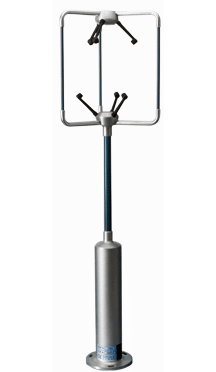Direct Covariance Flux
The Direct Covariance Flux sensor is an instrument package that collects vertical and horizontal wind components, air temperature and platform motion. These data are used to directly compute air-sea fluxes of momentum and buoyancy. The air-sea flux of momentum is the vertical transfer of horizontal momentum from the air to the ocean and is often referred to as the wind stress. The air-sea buoyancy flux is the vertical transfer of buoyancy associated with moist air and represents a mixture of sensible and latent heat exchange. Computation of the fluxes is accomplished using the motion-corrected direct covariance (MCDC) approach. This approach requires the system to measure the motion of the platform that can be used to compute the significant wave height and its direction. The system also provides the associated means and additional statistical measures of atmospheric turbulences and platform motion.
The system measures the horizontal and vertical wind components in the buoy reference frame using a 3-axis Gill Windmaster Pro (Model 1561-PK-020) sonic anemometer. The sonic anemometer also provides the speed of sound that is readily converted into sonic temperature, which closely approximates the virtual air temperature. The platform motion is characterized using a Microstrain (Model 3DM-GS5-25) Inertial Measurement Unit (IMU). This device integrates 3-axis linear accelerometers, 3-axis angular rate sensors (solid state gyros), and a 3-axis magnetometer. The data from the sonic anemometer and IMU are merged, time-stamped, and stored by a AA3355 1 Ghz ARM Cortex-A8 processor. The processor collects data for 20 minutes out of the hour and processes it during the 40 minute interval to generate the ancillary data telemetered to monitor system performance.
Data Products
This instrument measures the following data products. Select a data product's name to learn more.
| Data Product | Code | DPS |
|---|---|---|
| Direct Covariance Flux of Heat | FLUXHOT | |
| Direct Covariance Flux of Momentum | FLUXMOM | |
| Platform Direction and Tilt (3 axes) | MOTFLUX | |
| Turbulent Air Temperature | TMPATUR | DPS |
| Wind Velocity in 3 Dimensions | WINDTUR | DPS |
The algorithm code used to generate data products for this instrument is also available in the ion-functions GitHub repository.
Instrument Models & Deployed Locations
The OOI includes the following instrument makes and models for this instrument type. Follow the links below to find out where in the OOI this instrument has been deployed. You'll also find quick links for each instrument to Data Explorer, where you can plot and access data.
| Class-Series | Make | Model |
|---|---|---|
| FDCHPA | WHOI | DCFS |

